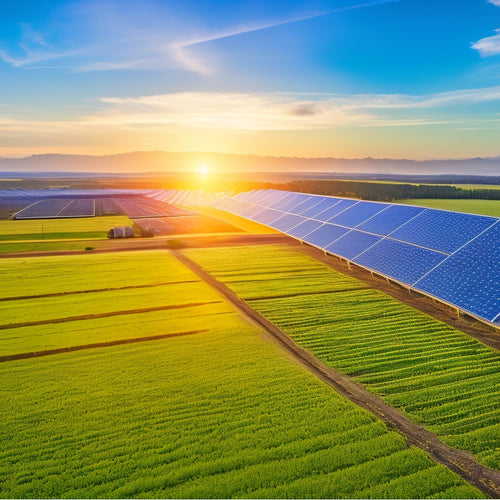
What Is the Cost of Industrial Solar Panels for Beginners
Share
You're likely wondering how much it'll cost to utilize the power of industrial solar panels to fuel your operations and reduce your carbon footprint. The average cost of installation ranges from $2.50 to $3.50 per watt, with a total installation cost for a 1-megawatt system ranging from $1 million to $3 million. Factors like panel quality, installation size, and manufacturer warranties influence the cost. Additionally, incentives like federal tax credits and state-specific rebates can greatly lower the upfront cost. As you weigh the financials, you'll want to reflect on the long-term benefits, including reduced energy costs and a lower carbon footprint - and there's more to investigate when it comes to optimizing your investment.
Key Takeaways
- Industrial solar panels cost between $2.50 to $3.50 per watt, with a 1-megawatt system costing $1 million to $3 million.
- Installation size and panel quality affect the overall cost, with larger installations generating more electricity but incurring higher upfront costs.
- Maintenance costs are necessary to ensure optimal performance and efficiency, with regular cleaning, inspection, and electrical testing required.
- Federal tax credits, such as the Solar Investment Tax Credit (ITC), and state-specific incentives can significantly lower the cost of solar panel installations.
- The payback period for industrial solar panels typically ranges from 5 to 10 years, depending on location, energy usage, and installation costs.
Understanding Industrial Solar Panels
When it comes to employing renewable energy, industrial solar panels have emerged as a viable solution for businesses and organizations seeking to reduce their carbon footprint.
As you investigate the potential of solar power, it's crucial to understand the technology behind industrial solar panels. These systems are designed to generate electricity on a large scale, making them ideal for commercial and industrial applications.
You'll find that industrial solar panels employ advanced solar panel technology, featuring high-efficiency photovoltaic cells that convert sunlight into electricity. This results in a significant reduction in greenhouse gas emissions and reliance on fossil fuels.
The renewable energy benefits of industrial solar panels are undeniable, with the potential to power entire facilities, reduce energy costs, and contribute to a cleaner environment.
Factors Affecting Solar Panel Cost
You'll find that the cost of industrial solar panels is influenced by several key factors, including panel quality variance and system installation size.
These factors can greatly impact the overall cost of your solar panel system, and understanding their effects is essential for making informed decisions.
Panel Quality Variance
Solar panel quality variance greatly affects the overall cost of industrial solar panels, with high-efficiency panels commanding a premium price. You'll find that top-tier manufacturers adhere to rigorous manufacturing standards, ensuring superior material durability and performance.
These high-quality panels boast higher panel efficiency, resulting in more power per unit area. Consequently, they come with longer performance warranties, often up to 25 years or more. This increased efficiency also leads to a reduced environmental impact, as fewer panels are needed to generate the same amount of power.
However, high-efficiency panels can pose installation obstacles, such as requiring specialized equipment and trained personnel. Despite these challenges, technology advancements have driven innovation, making high-quality panels more accessible.
Market trends suggest that as demand increases, prices will decrease, making high-efficiency panels a more viable option. When evaluating industrial solar panel costs, consider the long-term benefits of investing in high-quality panels, including increased energy output and reduced maintenance costs.
System Installation Size
High-efficiency panels may offer superior performance, but their cost is also influenced by the system installation size. When you're planning an industrial solar panel installation, you need to evaluate the installation capacity that suits your energy requirements. This sizing evaluation directly impacts the overall cost of your solar panel system.
A larger installation capacity typically translates to higher upfront costs, but it also means you'll generate more electricity and potentially reduce your energy bills. On the other hand, a smaller installation capacity may be more budget-friendly, but it mightn't meet your energy demands.
You'll need to strike a balance between installation size and energy output to optimize your investment.
When determining the ideal installation size, you'll need to assess factors like your energy usage patterns, available roof or land space, and local building codes. A thorough analysis of these factors will help you determine the most cost-effective installation capacity for your industrial solar panel system.
Types of Industrial Solar Panels
Industrial-scale solar power installations require panels that can withstand harsh environmental conditions and optimize energy output. You'll need to choose from various solar panel types, each with its own strengths and weaknesses. When selecting a photovoltaic technology, consider factors like efficiency, cost, and durability.
Here are some popular options:
-
Monocrystalline panels: Made from a single crystal of silicon, these panels offer high efficiency and long lifespan, but are also more expensive.
-
Polycrystalline panels: Composed of multiple silicon crystals, these panels are less efficient but more affordable than monocrystalline panels.
-
Thin film options: These panels use a thin layer of photovoltaic material, making them cheaper and more flexible, but less efficient.
Other options include bifacial modules, which can absorb light from both sides, and building integrated photovoltaics, which integrate solar panels into building structures.
Concentration photovoltaics, which use mirrors or lenses to focus sunlight, are also available. By understanding the different types of industrial solar panels, you can make an informed decision for your project.
Average Cost of Installation
Now that you've selected the right type of solar panel for your industrial project, it's time to contemplate the average cost of installation. This phase is critical, as it directly affects the overall project expense.
The average cost of installation varies depending on the project's scope, location, and complexity. On average, you can expect to pay between $2.50 and $3.50 per watt, with the total installation cost ranging from $1 million to $3 million for a 1-megawatt system.
When planning your installation, consider the installation timeline, which typically spans 3-6 months. This includes site preparation, panel installation, and connection to the grid.
To finance your project, you can investigate various financing options, such as power purchase agreements, capital leases, or cash purchases. Be certain to research and compare financing options to find the best fit for your business.
Cost of Solar Panel Maintenance
How much will you need to budget for ongoing maintenance to guarantee your industrial solar panel system operates at peak levels?
Proper maintenance is vital to confirming your system runs efficiently and effectively throughout its solar panel lifespan. Failing to perform regular maintenance can lead to reduced energy output, decreased efficiency, and even system failure.
To avoid these issues, it's important to establish regular maintenance schedules. Here are some key maintenance tasks to keep in mind:
-
Inspection and cleaning: Regularly inspect your solar panels to identify and clean debris, dirt, and other obstructions that can reduce energy output.
-
Electrical testing: Perform electrical tests to verify your system is operating within safe and ideal parameters.
-
Inverter maintenance: Regularly inspect and maintain your inverters to guarantee they're functioning correctly and efficiently.
Incentives for Industrial Solar
You'll be pleased to know that there are several incentives available to help offset the cost of industrial solar panels.
For instance, federal tax credits can greatly reduce your tax liability, allowing you to reap the benefits of solar energy while minimizing your expenses.
Additionally, many states offer their own incentives, such as rebates or grants, which can further reduce the upfront cost of installing industrial solar panels.
Federal Tax Credits
The federal government offers significant incentives for industrial solar panel installations through the Solar Investment Tax Credit (ITC).
As a business owner, you can claim a substantial portion of your investment in solar panels as a tax credit, reducing your taxable income. This incentive is a major driver of the adoption of solar energy in the industrial sector.
To be eligible for the ITC, you'll need to meet specific requirements, including:
-
Placing your solar panel system in service during the tax year: This means your system must be operational and generating electricity to qualify for the tax credit.
-
Owning the solar panel system: You must have a financial stake in the system to claim the tax credit.
-
Meeting the ITC's reduction in basis rules: This guarantees that the tax credit is claimed only on the eligible portion of your investment.
State Incentives Available
Beyond federal incentives, many states offer additional benefits to encourage the adoption of industrial solar panels. You'll find that state regulations and local programs vary, but they often provide financial assistance to offset the upfront cost of installation.
For instance, some states offer tax rebates or grant opportunities to businesses that invest in industrial solar panels. These incentives can greatly reduce the cost of going solar, making it a more viable option for your business.
Additionally, utility incentives and solar financing options may be available to help you get started. By taking advantage of these state incentives, you can maximize your energy savings and increase your return on investment.
Be sure to research the specific programs available in your state and local area, as they can change over time. By doing so, you'll be well on your way to utilizing the power of industrial solar panels and reaping the benefits of renewable energy.
Comparing Industrial Solar Brands
Several industrial solar brands are vying for your attention, each claiming to offer the most efficient and cost-effective solutions for your business. As you traverse the market, it's crucial to assess these brands based on key factors that impact your bottom line.
-
Brand reputation: Research companies with a proven track record of providing high-quality products and services. Look for certifications, awards, and industry recognition.
-
Panel efficiency and energy output: Compare the efficiency ratings of different panels, as well as their expected energy output. This will help you determine which brand can provide the most power per installation.
-
Warranty options and installation experience: Evaluate the warranty terms, including duration, coverage, and maintenance requirements. Also, consider the installation experience, including the quality of the installers and the overall process.
When comparing industrial solar brands, you should also consider pricing strategies, market trends, and customer reviews. By assessing these factors, you'll be able to make an informed decision that meets your business needs and budget.
Payback Period for Industrial Solar
As you weigh the costs and benefits of industrial solar panels, calculating the payback period becomes a critical step in determining their feasibility for your business. This metric helps you understand how long it takes to recoup your investment in solar energy.
To calculate the payback period, you'll need to evaluate the upfront cost of the system, ongoing expenses, and projected solar savings. A thorough investment analysis will help you determine the payback period.
You'll need to factor in the initial investment, including hardware, installation, and maintenance costs. Then, estimate the annual solar savings based on your energy usage and the system's expected performance. By dividing the total investment by the annual solar savings, you'll get the payback period.
A shorter payback period indicates a more attractive investment. Typically, industrial solar panels have a payback period ranging from 5 to 10 years. However, this can vary depending on your location, energy usage, and system design.
Is Industrial Solar Worth It
Now that you've calculated the payback period, it's time to reflect on the ultimate question: is industrial solar worth it for your business? The answer depends on several factors, including your company's energy consumption, budget, and long-term goals.
If you're looking for industrial energy savings and a way to reduce your carbon footprint, industrial solar can be an important investment.
Here are a few benefits to evaluate:
-
Significant energy savings: Industrial solar panels can help you save thousands of dollars on your energy bills each year.
-
Solar financing options: Many financing options are available, including power purchase agreements (PPAs) and solar leases, which can help minimize upfront costs.
-
Increased property value: Installing industrial solar panels can increase your property value and attract environmentally conscious customers.
Frequently Asked Questions
Can I Use Residential Solar Panels for Industrial Purposes?
You can't use residential solar panels for industrial purposes; they're designed for smaller energy needs, with lower panel efficiency. Industrial solar panels are built for high-capacity energy production, with higher efficiency rates to support large-scale operations.
Do Industrial Solar Panels Require Special Installation Training?
You'll need specialized training for industrial solar panel installation, ensuring you hold installation certification and can design complex system designs that meet industrial power demands, requiring a deeper understanding of electrical infrastructure and safety protocols.
How Long Do Industrial Solar Panels Last on Average?
As you utilize the sun's fiery power, you'll want to know your industrial solar panels will shine bright for years to come. On average, they'll last around 30 years, with lifetime expectations slowly dwindling due to panel degradation, but still generating a substantial amount of electricity.
Are Industrial Solar Panels Compatible With Existing Electrical Systems?
You'll be relieved to know that industrial solar panels are designed for seamless grid integration, ensuring system compatibility with your existing electrical infrastructure, allowing for a smooth shift to renewable energy without compromising your power supply.
Can I Finance Industrial Solar Panel Installations Through Loans?
You'll be surprised to know that 70% of commercial solar installations are financed through loans! Yes, you can finance industrial solar panel installations through loans, exploring solar financing options that offer industrial loan benefits, such as tax incentives and reduced energy costs.
Conclusion
Now that you've got an all-encompassing understanding of industrial solar panels, it's time to utilize the power of clean energy for your business. Did you know that the global industrial solar market is projected to reach $143.6 billion by 2025, growing at a CAGR of 12.4%? With the right installation, maintenance, and incentives, industrial solar panels can be a smart investment for your company, leading to significant cost savings and a reduced carbon footprint.
Related Posts
-

Solar Power for Reducing Carbon Footprint
Solar power is an effective strategy for reducing your carbon footprint. By adopting solar energy, you can cut greenh...
-

Innovative Sustainable Materials for Energy-Efficient Homes
Innovative sustainable materials enable you to create energy-efficient homes while promoting environmental responsibi...
-

Green Energy Alternatives for Independent Living
To enhance your independent living, consider green energy alternatives like solar panels and wind turbines. These opt...


